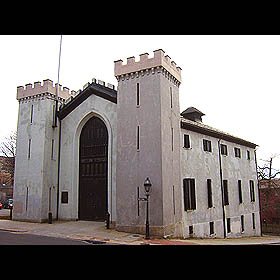
Overview
Few buildings along Benefit Street standout like the Benefit Street Arsenal. Both in its façade and use, the Arsenal offers a pleasant surprise among the already varied Benefit Street, soliciting the passerby to stop for at least a moment to look over the structure. Constructed in 1839 out of chipped stone covered in cement, which was originally incised to replicate stone, Russell Warren’s building appears as an edifice from another time, and one totally un-American, much like his Manning Hall on the Main Green of Brown University. Calling up easily recognizable visual references, Warren marks both structures by his use of painted stucco, formed and grooved to appear as stone, as genuflecting copies of more venerable monuments.
Description
With turreted towers on either side of a tall imposing entryway, the arsenal recalls almost a caricature of medieval defenses. A row of small windows just below the roofline, shuttered by wooden slats and iron hardware painted black, provide a small relief to the otherwise flat grey walls. Tall thin slits punctuate the turrets at either side of the entrance, recalling elongated arrow slots. A thin two story portal marks the main entrance to the arsenal, replete with a strong wooden door and metal gate, coming to a simple gothic pointed arch close to the point of the angled roof. Simple crenellation works around the top of the building, a detail that highlights the signifying elements of fortification. The interior plan consists primarily of a large, open hall accessed directly from the front door of the building. A set of bronze plaques decorates the exterior façade, listing of the building’s historic significance and marking it as a part of the National Register of Historic Places.
History
While the structure was only actively used by the Kentish Guards during the Dorr Rebellion of 1842, the building played another role in the development of Providence by being moved 150’ in 1906 to make way for a railroad tunnel into the city. The structure currently sits under a lease to the Providence Marine Corps of Artillery as a museum and meeting house, but also actively participates as a hall for such events as church meetings and other civic events.
Sources
Brown, Colonel Howerd F. and Roberta Mudge Humble. The Historic Armories of Rhode Island.
William McKenzie Woodward, Edward F. Sanderson, Providence, A Citywide Survey of Historic Resources (RI Historic Preservation Commission, 1986), p. 142.












